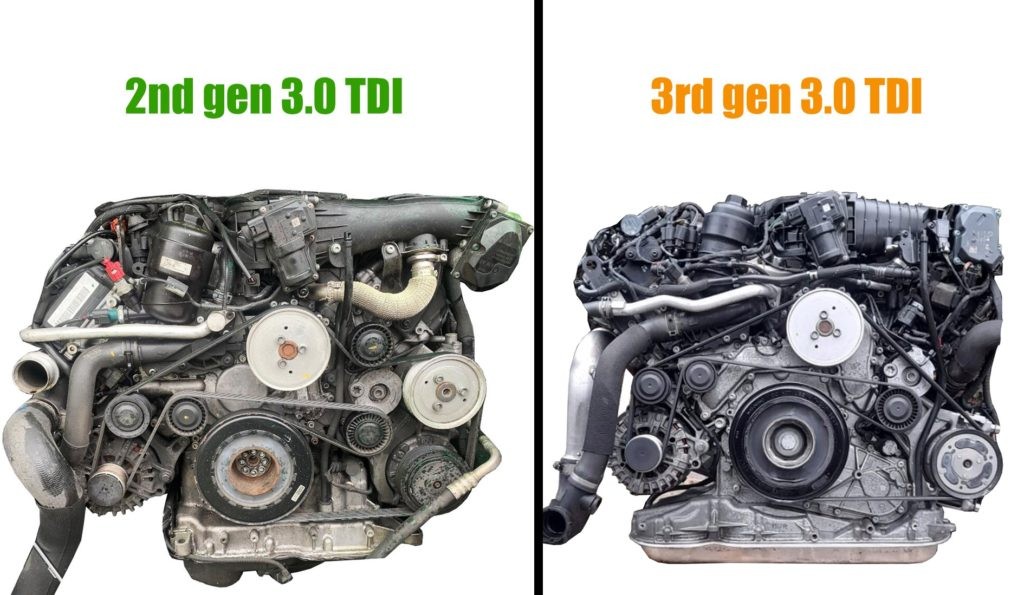The Audi 3.0 TDI engine, particularly the second-generation (2nd gen), represents a powerful and efficient diesel option. Renowned for its potential longevity, exceeding 500,000 km (310,000 mi) is achievable with proper maintenance. However, this generation introduces complexities, particularly with increased plastic components, compared to its robust predecessor, the 1st gen 3.0 TDI. This article delves into the intricacies of the 2nd gen 3.0 TDI, highlighting its strengths, weaknesses, and common issues.
Design and Updates in the 2nd Gen 3.0 TDI
The 2nd gen Audi 3.0 TDI retains the core architecture of the 1st gen: a V6 common rail diesel with a cast-iron block, aluminum cylinder heads, and a single turbocharger (except for the BiTDI variant with twin turbos). Key updates include:
- Simplified variable intake manifold with two flaps.
- Redesigned timing chain mechanism.
- Updated EGR and cooling systems.
- Integrated vacuum pump within the oil pump.
- New oil filter housing, valve covers, and front engine cover.
While these revisions aimed for improved reliability, the increased use of plastic components introduced new points of failure and potential leaks. Despite these concerns, the engine remains fundamentally sound, capable of high mileage with diligent upkeep. It’s commonly found in various Audi models (A4, A6, A8), VW Touareg, Porsche Cayenne, and even the first-generation Porsche Panamera. Noteworthy is that some models, like the A6 (C7) and A7 (C7), might also house the 3rd gen 3.0 TDI.
Common Issues with the Audi 3.0 TDI Engine
While durable, the 2nd gen 3.0 TDI isn’t without its problems. Common issues include:
Fuel System Concerns
- Injectors: Injectors can malfunction around 200,000 km, and injector washers might leak even earlier, around 100,000 km.
- Injector Bolts: These can loosen or break, causing injector ejection and symptoms like rattling, check engine light, limp mode, and misfires.
- High-Pressure Fuel Pump (HPFP): The Bosch CP4 pump can suffer mechanical failure, contaminating the fuel system with metal particles and damaging injectors. This is less frequent but more common in regions with varying fuel quality. Using high-quality fuel and additives can mitigate this risk.
Turbocharger and Crank Pulley Issues
- Turbocharger: The turbocharger and its electronic actuator can fail, typically in high-mileage vehicles exceeding 300,000 km.
- Crankshaft Pulley: Similar to the 1st gen, the crankshaft pulley is prone to degradation, potentially causing the accessory belt to detach. Preventative replacement is recommended upon noticing wear or rust.
Oil and Coolant Leaks
Numerous points throughout the engine are susceptible to oil and coolant leaks, primarily due to the increased use of plastic components and seals:
- Oil Leaks: Valve cover gaskets, oil cooler gaskets, oil thermostat o-ring, oil filter housing seals, rear main seal, and various covers sealed with factory sealant.
- Coolant Leaks: Oil cooler, plastic coolant flange, coolant regulating valve, plastic coolant cover (requiring extensive disassembly for replacement), oil filter housing (containing the thermostat), and plastic coolant pipe.
Addressing these leaks often requires a comprehensive approach, replacing multiple gaskets and plastic parts simultaneously to avoid recurring issues.
Timing Chain Concerns
Although redesigned for simplicity, the timing chain mechanism can still wear prematurely, particularly in models produced before 2013 due to a weaker tensioner. While a brief rattle on startup might not indicate immediate failure, it signals potential issues requiring attention. Preventative replacement around 300,000 km is advisable, even without noticeable rattling.
Other Potential Problems
- Carbon Buildup: Intake manifold cleaning is recommended around 150,000 km to improve performance and fuel efficiency.
- Sensor/Switch Failures: Various sensors and switches can malfunction.
- EGR/Throttle Body Issues: Problems can arise with the EGR valve and throttle body actuator.
- Vacuum Solenoid: Failure of the vacuum solenoid can lead to coolant temperature fluctuations and a P199E fault code.
- Dieselgate Software: Vehicles with the dieselgate software update might experience increased fuel consumption, rough running, reduced power, and more frequent DPF regeneration cycles. Downgrading to the original software version can alleviate these issues.
- Variable Oil Pump: The pressure regulating valve in the variable oil pump is recommended for preventative replacement after 200,000 km. Using genuine parts is crucial. Leaking head gaskets or cracked cylinder heads are more prevalent in heavier SUVs using this engine. Careful inspection for coolant loss, oil in coolant, and related symptoms is crucial before purchase.
The 2nd gen Audi 3.0 TDI engine offers a blend of power and efficiency but demands meticulous maintenance. While capable of high mileage, its increased complexity and reliance on plastic components introduce potential points of failure. Understanding these common issues is crucial for owners and prospective buyers to ensure the engine’s longevity and avoid costly repairs.

